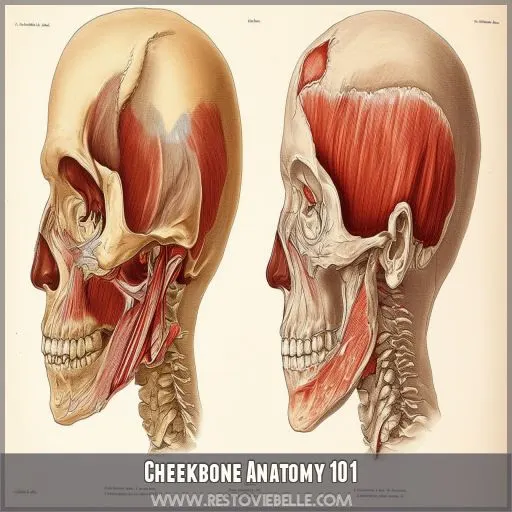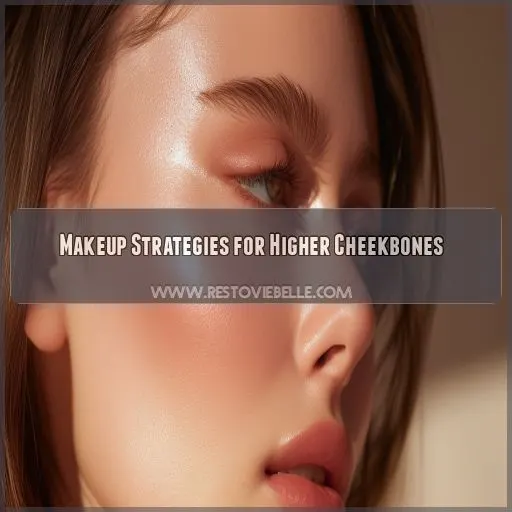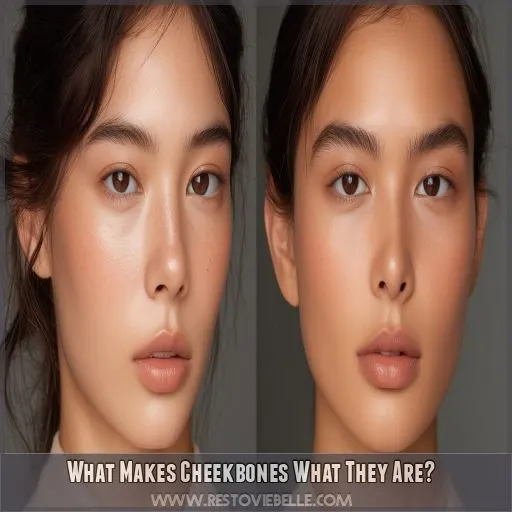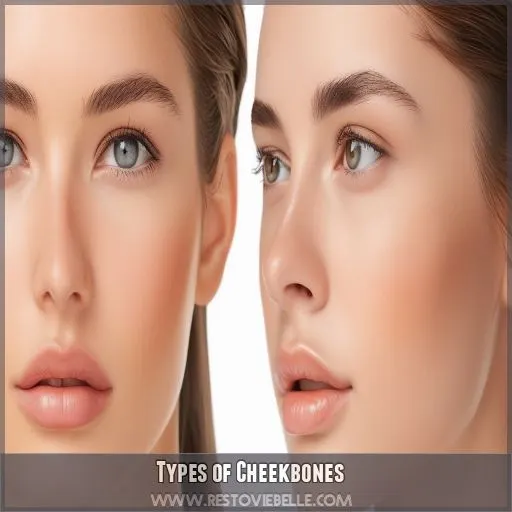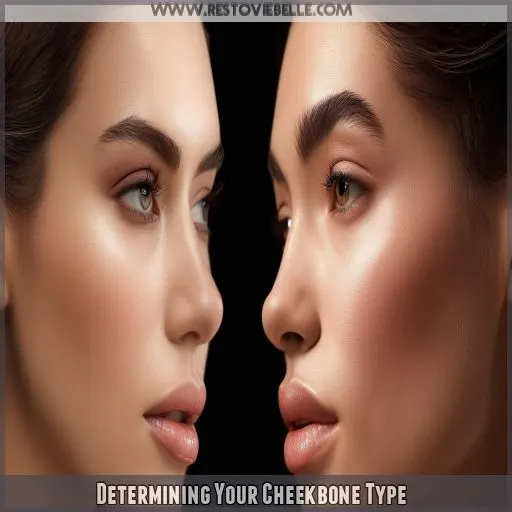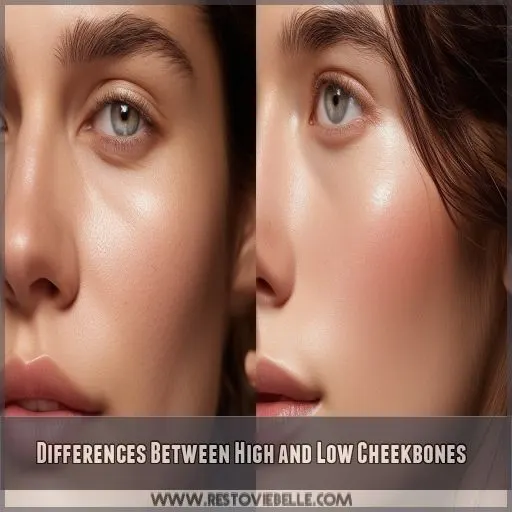This site is supported by our readers. We may earn a commission, at no cost to you, if you purchase through links.
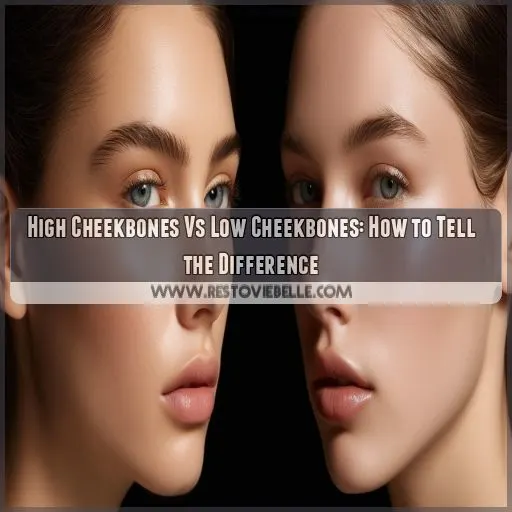 Did you know that the position of your cheekbones can influence how others perceive you?
Did you know that the position of your cheekbones can influence how others perceive you?
high cheekbones versus low cheekbones has been a topic of interest, especially in the beauty industry.
This article will explore the differences between high and low cheekbones, the facial aesthetics they create, and the underlying factors that determine your cheekbone type.
Whether you’re curious about your facial structure or seeking ways to enhance your features, understanding the distinction between high and low cheekbones can provide valuable insights into your unique appearance.
Let’s get started on this exploration of cheekbone anatomy and the impact it has on our faces.
Table Of Contents
- Key Takeaways
- Cheekbone Anatomy 101
- Makeup Strategies for Higher Cheekbones
- What Makes Cheekbones What They Are?
- Types of Cheekbones
- Determining Your Cheekbone Type
- Differences Between High and Low Cheekbones
- Altering Your Facial Structure for Higher Cheekbones
- Frequently Asked Questions (FAQs)
- Are high or low cheekbones more attractive?
- What ethnicity has high cheekbones?
- How do I find if I have high or low cheekbones?
- What race has low cheekbones?
- Are high cheekbones linked to jawline definition?
- Do people with high cheekbones have higher estrogen levels?
- Can you change your cheekbone type with diet?
- What are the risks of cheek implants?
- Are high cheekbones linked to attractiveness?
- Conclusion
Key Takeaways
- Cheekbones are shaped by a mix of genetics and ethnicity, with your DNA and cultural background influencing their structure and position.
- High cheekbones sit closer to the eyes, creating a defined, angular look, while low cheekbones hang out near the nose, giving a softer, less dramatic appearance.
- Makeup techniques like contouring and highlighting can enhance your cheekbones and create a more defined look without going under the knife.
- High cheekbones are often associated with attractiveness, trustworthiness, and youthfulness, tapping into our evolutionary radar for good genes and fertility.
Cheekbone Anatomy 101
First things first: let’s get you familiar with the ins and outs of cheekbone anatomy. This is key to understanding the difference between high and low cheekbones and how to tell them apart.
Genetics and Ethnic Influence on Cheekbone Structure
Cheekbones, those all-important facial features, are shaped by a combo of genetics and ethnicity.
Your genetic background sets the blueprint for your facial structure, including those coveted malar bones.
But it’s not just DNA calling the shots here – ethnic influences also play a huge, often overlooked, role in how your cheekbones develop.
Locating Your Cheekbones: a Simple Guide
A Simple Guide
Finding your cheekbones is easy if you know where to look. Here’s a simple guide to help you locate those cheekbones:
- Start with your thumbs: Place your thumbs on the tragus (that’s the cartilage above your ear canal).
- Index fingers on the nose: Yep, you guessed it – place your index fingers on your nostrils.
- Bring ’em together: Slowly bring those thumbs and index fingers together until they meet.
- Feel the bone: Gently press down, and voila! You’ve found your cheekbone.
Now you know where your cheekbones are, you can figure out if they’re high or low. If they’re closer to the bottom of your nose, they’re low cheekbones. If they’re nearer the bridge of your nose, you’ve got high cheekbones.
High Vs. Low Cheekbones: What’s the Difference?
So, what’s the deal with high and low cheekbones?
Well, it all comes down to bone structure. High cheekbones mean your malar bones sit closer to your eyes, giving your face a more defined, angular look. Low cheekbones, on the other hand, are when those same bones hang out closer to your nose, resulting in a softer, less dramatic appearance.
It’s like choosing a seat at the movies—front row for high cheekbones, back row for low.
Makeup Strategies for Higher Cheekbones
So you want to enhance those cheekbones and make ’em pop? Makeup is a fun and easy way to accentuate your features and create a more defined look. Let’s get into some simple strategies to highlight those gorgeous bones!
Contouring Techniques for a Natural Look
Want higher cheekbones without going under the knife? Makeup is your magic wand. Here’s how to contour like a pro:
- Choose the Right Shades: Go for a bronzer or blush two shades darker than your skin tone. This adds depth and definition to your cheekbones.
- Placement is Key: Apply the contouring shade along your cheekbone and up to your eyebrow line. This creates a natural-looking shadow that enhances your bone structure.
- Blend, Blend, Blend: Use a fluffy brush to blend upwards and outwards. This helps create a smooth finish and prevents any harsh lines.
- Practice Makes Perfect: Experiment with different contouring shades and techniques to find what works best for your face structure. Practice contouring on yourself or ask a friend for feedback.
Highlighting to Accentuate Cheekbones
Now, let’s talk about highlighting. This technique is all about bringing attention to your cheekbones and making them pop.
To accentuate your cheekbones with makeup, reach for a highlighter. Apply it directly under your eyes, following the natural curve of your bone structure. This simple step can make a huge difference in defining your features.
| Technique | Placement | Effect |
|---|---|---|
| Highlighting | Under the eyes | Accentuates the cheekbone |
With highlighting, you can easily enhance your cheekbones and create a more defined look.
Blending for a Seamless Finish
The key to a natural look is blending, blending, blending! You don’t want harsh lines or obvious changes. Here’s how to blend like a pro:
- Use the right tools: Opt for soft, fluffy brushes designed for blending.
- Light hand, heavy impact: Go easy on the product application. You can always add more, but it’s harder to remove excess.
- Buff and blend: Use gentle, circular motions to buff the product into your skin. This creates a smooth finish.
- Transition tones: Avoid harsh contrasts by blending darker contour shades into your natural skin tone.
What Makes Cheekbones What They Are?
You might be wondering why some people have high cheekbones while others have low cheekbones. Well, it’s a combination of factors, and we’re here to break it down for you.
Get ready to discover the science behind those cheekbones and explore the fascinating reasons why they vary from person to person.
Genetics and Ethnicity: the Primary Influencers
Your cheekbones are a big part of your face, and your genes and ethnicity play a big role in how they look.
Your ethnic background and genes are the main factors that influence how your cheekbones develop. This includes their shape, position, and overall appearance. It’s all down to your DNA.
Bone Structure and Estrogen Levels: the Connection
Let’s talk about the link between bone structure and estrogen levels. Ever wondered why some people have those high cheekbones? Here’s the deal:
- Estrogen’s Role: Estrogen, the main female sex hormone, plays a big part in bone health. It controls bone density and shapes your bones, including those cheekbones.
- Cheekbone Height: Higher estrogen levels are often linked to higher cheekbones. So, if you’ve got naturally high estrogen, your cheekbones might be closer to your eYes.
- Beauty and Bone Structure: The connection between estrogen and cheekbones shows how hormones and beauty are connected. It’s not just about makeup and fashion; it’s about the very foundation of your face.
Primitive Dispositions and Trustworthiness: the Psychological Aspect
Why do people pay big bucks for cheekbone enhancements? Evolutionary psychology has some answers.
Some people are drawn to high cheekbones because our brains associate beauty with fertility. It’s an evolutionary thing—like a primitive radar for good genes.
But there’s more. High cheekbones also signal trustworthiness. So, when you rock those prominent cheekbones, you’re not just serving looks, you’re giving off trustworthy vibes, too. Nature’s way of saying, "Hey, I’ve got your back and I’m here to stay.
Types of Cheekbones
There’s more to cheekbones than meets the eye – or nose, for that matter. High or low, sunken or protruding, your cheekbones play a starring role in your face’s overall appearance.
Let’s take a closer look at the different types of cheekbones and how they shape your look.
High Cheekbones: Definition and Characteristics
High cheekbones are a prominent feature that gives your face a defined and sculpted look.
They’re all about the location of your malar bones – the higher they sit, the closer they’re to your eyes, creating that sought-after angular and chiseled appearance.
It’s like having natural contouring, giving your face a boost of definition and dimension.
This look is often associated with beauty and perceived as a sign of fertility and trustworthiness, tapping into some deep-rooted instincts.
Low Cheekbones: Definition and Characteristics
Understanding Their Unique Characteristics
Low cheekbones are all about that subtle, understated beauty. Here’s a breakdown of what defines them:
- Malar Bone Placement: The key difference is in the position of your malar bones. With low cheekbones, these bones sit closer to the bottom of your nose, aligning with your nostrils.
- Facial Structure: Low cheekbones often give your face a softer, less angular look. It’s like your face is saying, "Hey, I’m here, but I’m not trying to steal the spotlight."
- Volume and Definition: Cheeks with low cheekbones might appear flatter and less defined. Don’t worry, it’s not a bad thing! It’s just your unique brand of gorgeousness.
- Ogee Curve: The curve from your ear to your nose is typically shorter with low cheekbones. It’s like a secret code that only the most discerning eyes can crack.
- Jawline Impact: A defined jawline can make your low cheekbones even more noticeable. It’s all about balance, creating a subtle yet striking harmony in your facial features.
Sunken, Flat, and Prominent Cheekbones: the Variations
Let’s talk about the different types of cheekbones out there.
You’ve got the sunken kind, which can give off a hollow vibe. Then there’s the flat crew, keeping it low-key and subtle. And last but not least, we’ve got the prominent posse, rocking that bold and defined look.
Determining Your Cheekbone Type
Ever wondered if your cheekbones are high or low? Well, wonder no more! In this section, we’ll show you how to figure out your unique cheekbone type.
Finger Placement and Ogee Curve Length: the Measurements
Now, let’s get into the specifics of determining your cheekbone type through finger placement and Ogee curve length. It’s time to get technical!
Finger Placement: Feel your cheekbones. High cheekbones are closer to the eyes, while low cheekbones are nearer the nostrils.
Ogee Curve Length: Measure the curve from ear to nose. A longer curve indicates higher cheekbones.
Signs of High Cheekbones Vs. Low Cheekbones
So, how can you tell if your cheekbones are high or low? Well, it’s pretty simple. If your cheekbones are closer to your eyes, then you’ve got high cheekbones. If they’re hanging out closer to your nostrils, then you’ve got low cheekbones. Easy, right?
Now, there are a few other things that can give you a hint, too. If you’ve got an oval face, chances are your cheekbones are on the lower side. And if you’re on the thinner side, your low cheekbones might be more noticeable.
Differences Between High and Low Cheekbones
So, what’s the real deal between high and low cheekbones? Well, it all comes down to the bone structure of your face.
High cheekbones sit closer to your eyes, while low cheekbones hang out nearer to your nose. But that’s not all – your jawline definition, malar bone position, and facial shape can also play a part in how prominent those cheekbones look.
Facial Bone Structure: the Primary Difference
The Primary Difference
The main difference between high and low cheekbones? It’s all about the bone structure of your face. Here’s the lowdown:
- High cheekbones: These babies are snuggled closer to your eyes, giving that sculpted, defined look to your upper cheeks.
- Low cheekbones: They’re chilling nearer to the bottom of your nose, resulting in a softer, less angular vibe with less volume and definition in the cheeks.
- It’s all about the malar bones and their location.
- Fun fact: A defined jawline can make those high cheekbones pop even more.
Jawline Definition and Malar Bone Position: the Correlation
The relationship between jawline definition and malar bone position is key to understanding the differences between high and low cheekbones.
A well-defined jawline can enhance the appearance of high cheekbones, making them seem more pronounced.
Conversely, a softer jawline can create the illusion of lower cheekbones, even if the malar bones are positioned higher.
It’s all about the interplay between angles and shadows, sculpting the contours of your face.
Facial Shape and Personal Preference: the Variables
It’s All About You
The beauty of facial features is that they’re unique to you. The shape of your face can affect how prominent your cheekbones look. An oval face, for instance, tends to showcase lower cheekbones. But, hey, it’s not just about bone structure—it’s also about what you find attractive. Some folks adore the look of higher cheekbones, while others fancy lower cheekbones. It’s about embracing your natural beauty and rocking it with confidence.
At the end of the day, whether you prefer high or low cheekbones is entirely up to you. It’s your face, your rules!
Altering Your Facial Structure for Higher Cheekbones
So, you’re not thrilled with your cheekbones and want to take action. Whether you’re seeking a subtle lift or a dramatic transformation, there are several ways to alter your facial structure and achieve those coveted high cheekbones. From non-invasive techniques to surgical procedures, we’ll explore the options to help you decide which path is right for your desired look.
Mewing: the Ultimate Jaw and Cheekbone Defining Method
If you’re not up for going under the knife or needle, mewing is a technique you can try to enhance your jaw and cheekbone definition. It’s all about tongue posture, encouraging your jaw muscles to grow and strengthen, which then boosts your cheekbones’ prominence.
It’s a less invasive option that might appeal to those who want to skip the risks and costs of surgery or fillers.
Facial Implants, Dermal Fillers, and Makeup Techniques: the Options
Your Options for Higher Cheekbones
If you’re seeking more prominent cheekbones, you’ve got options beyond accepting your genetics. Here are three ways to enhance your cheekbones:
- Facial Implants: Opt for surgical procedures like cheek implants or fat transfers to add volume and structure.
- Dermal Fillers: Try injectables with hyaluronic acid for a temporary boost that lasts up to three months.
- Makeup Techniques: Contouring with bronzer or blush, and highlighting under the eyes, can create the illusion of higher cheekbones.
Plastic Surgery, Facial Exercises, and More: the Alternatives
Exploring All the Alternatives
If you’re seeking more dramatic changes, plastic surgery is an option. Procedures like cheek augmentation or cheekbone reduction can enhance or alter your cheekbones. Keep in mind that surgery comes with risks, potential side effects, and a hefty price tag.
Facial exercises targeting your cheek muscles can help strengthen and tone the area, contributing to a more defined appearance. While it may not be as drastic as surgery, consistent facial workouts can make a noticeable difference over time.
Frequently Asked Questions (FAQs)
Are high or low cheekbones more attractive?
Beauty standards vary, but high cheekbones are often prized as a marker of attractiveness. This perception may stem from beauty norms set by influencers and magazines, and the fashion and beauty industries. High cheekbones can also make a person seem more trustworthy and youthful.
What ethnicity has high cheekbones?
High cheekbones are a distinctive feature of various ethnic backgrounds, including Asian, African, Amerindian, Central and Eastern European, and Native American.
How do I find if I have high or low cheekbones?
You can determine your cheekbone type by feeling the position of your malar bones. If they’re closer to your eyes, you have high cheekbones. If they’re closer to your nostrils, you’ve got low cheekbones.
What race has low cheekbones?
It’s important to remember that cheekbone structure varies among individuals and beauty standards differ across cultures. That said, people of West Asian descent typically have low cheekbones.
Are high cheekbones linked to jawline definition?
Yes, high cheekbones can make your jawline appear more defined and your face look more symmetrical. This is especially true for women, as high cheekbones are associated with youthfulness and high estrogen levels.
Do people with high cheekbones have higher estrogen levels?
Yes, studies show that people with high cheekbones are perceived to have higher estrogen levels. This is linked to fertility and youthfulness, which may explain the universal appeal of high cheekbones.
Can you change your cheekbone type with diet?
While you can’t change your bone structure without surgery, a healthy diet and exercise can influence your cheekbones by reducing fat in your face. Eating certain foods like spinach, tangerines, and oysters may also help define your cheekbones.
What are the risks of cheek implants?
You might be thinking about getting cheek implants to make your cheekbones pop, but before you do, it’s good to know the deal. Like any surgery, it’s not without risks. Possible complications include bleeding, nerve damage, deep vein thrombosis, and even implant displacement. So, choose your surgeon wisely.
Are high cheekbones linked to attractiveness?
High cheekbones are linked to attractiveness. They’re associated with trustworthiness and are often deemed appealing due to their angular, structured shape. High cheekbones can enhance symmetry and definition, which are key indicators of attractiveness.
Conclusion
So, there you have it.
High cheekbones vs. low cheekbones isn’t just a beauty industry debate.
It’s a fascinating insight into how our faces are structured and perceived.
Now you know the difference, you can spot the subtle variations in cheekbone heights and even enhance your own with makeup tricks or more permanent solutions.
It’s amazing how a little understanding of cheekbone anatomy can go a long way toward boosting your confidence and sense of style.

